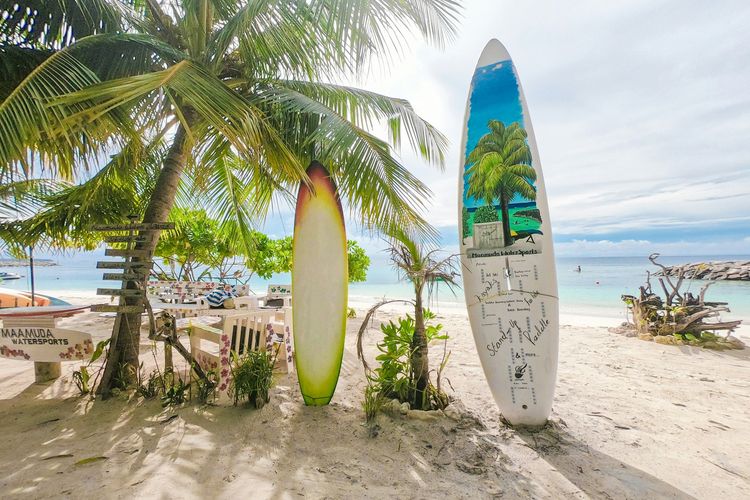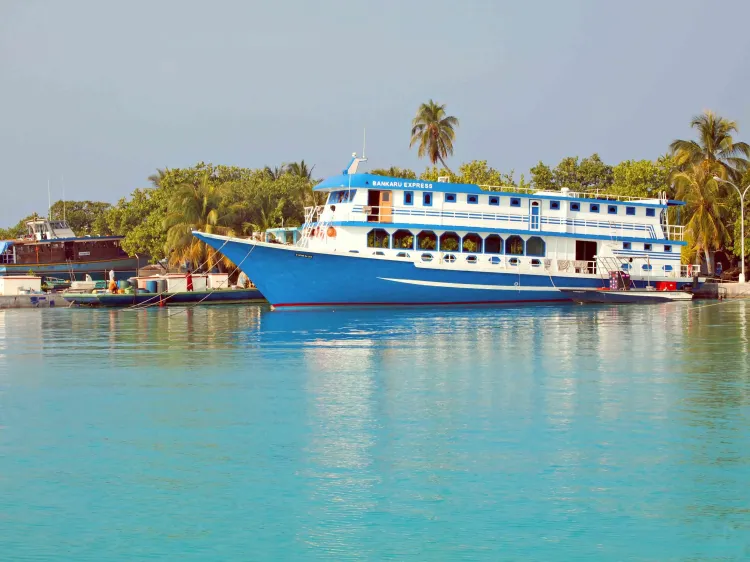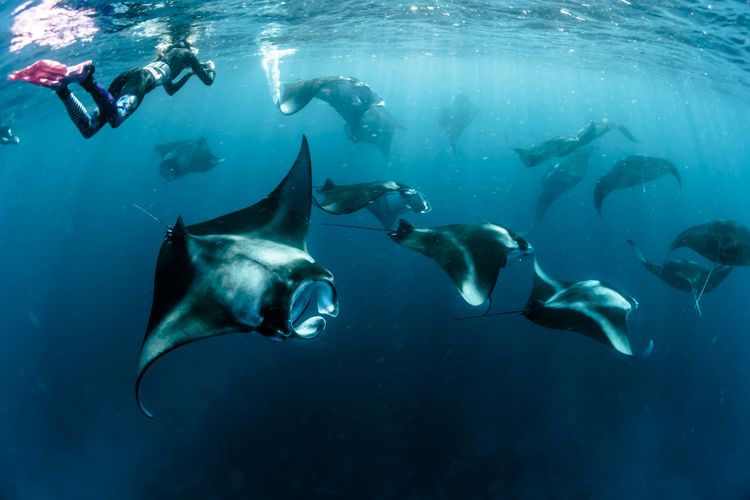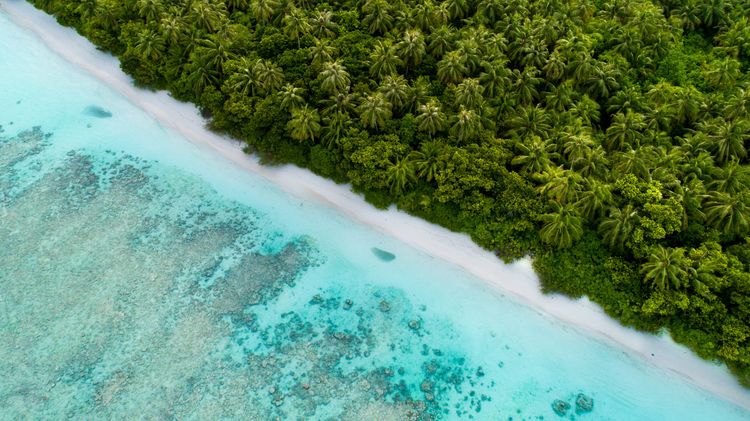Imagine slipping into crystal-clear waters just meters from your guesthouse door, only to find yourself face-to-face with a 20-foot whale shark gliding gracefully through the blue. As you float above vibrant coral gardens teeming with parrotfish and Napoleon wrasse, your local guide points out a manta ray soaring overhead like an underwater eagle. This isn't a once-in-a-lifetime resort excursion costing thousands – it's Tuesday morning on a Maldivian local island, where world-class marine encounters happen for the price of a city coffee, and your biggest decision is whether to snorkel before or after breakfast with your island host family.
Since 2009, when the Maldivian government allowed locals to open guesthouses on inhabited islands, budget travelers have discovered they can experience the stunning beauty of the Maldives for as little as $50 a day. What was once an exclusive playground for the ultra-wealthy has transformed into an accessible destination where authentic culture meets tropical perfection.
Everything you need to know about visiting Maldives local islands
How much does staying on local islands cost?
Guesthouse accommodation ranges from $50-$150 per night, with meals costing $15-$30 and activities around $25-$100
Budget Breakdown →
Which local islands should I visit?
Maafushi (budget-paradise, whale-sharks, diving), Dhiffushi (surfing, budget, authentic), and Hulhumale (convenient, modern, budget) top most lists
Best Islands →
How do I get between local islands?
Public ferries cost just $1-$4 per person, while speedboat transfers range $20-$75 depending on distance
Transportation Guide →
Can I see whale sharks and manta rays?
South Ari Atoll offers year-round whale shark encounters, with high success rates especially around Dhigurah and Maamigili
Marine Life Encounters →
What cultural rules should I know?
Dress modestly outside designated bikini beaches, alcohol is prohibited on local islands, and Islamic customs are observed
Cultural Guidelines →
When is the best time to visit?
Dry season (December-April) offers perfect weather while wet season (May-November) provides 30-50% savings and excellent marine life encounters
Timing Guide →
The Local Island Revolution
In 2009, the Maldivian government made a momentous policy shift that finally allowed locals a piece of the economic pie. Before this change, tourists were confined to expensive resort islands, completely separated from authentic Maldivian life. Today, around 200 inhabited local islands welcome tourists wholeheartedly, offering an unprecedented opportunity to experience genuine island culture while enjoying the same stunning beaches that make the Maldives famous.
Local Islands: $50-$150/night • Authentic culture • Budget activities • No alcohol • Islamic customs
Resort Islands: $500-$3000+/night • Luxury amenities • All-inclusive • Alcohol available • Western atmosphere
The beauty of local island travel lies in its authenticity. You can experience real Maldivian celebrations like Eid, festivals, and community events that happen throughout the year. Instead of being confined to a single resort island, you can island-hop through different communities, each with its own personality and charm.
Top Local Islands to Visit
Premium Picks (Popularity Rating 8-10)
Maafushi (budget-paradise, whale-sharks, diving) - Popularity Rating: 10 The undisputed king of local island tourism, Maafushi is the most developed local island for tourists and offers fantastic value accommodation, a beautiful bikini beach, lots of dining options, and easy access to whale shark excursions. Located in South Male Atoll, it's just $25 by speedboat or $2 by public ferry from the airport.
Dhiffushi (surfing, budget, authentic) - Popularity Rating: 9 A surfing paradise in Kaafu atoll, Dhiffushi offers excellent breaks and a more laid-back atmosphere than Maafushi. Perfect for budget travelers seeking both adventure and authenticity.
Hulhumale (convenient, modern, budget) - Popularity Rating: 9 Just minutes from the airport, this artificial island offers modern amenities and easy access. Ideal for those with early flights or wanting convenience without resort prices.
Dharavandhoo (hanifaru-bay, manta-rays, diving) - Popularity Rating: 8 Located in Baa atoll, this island provides access to the famous Hanifaru Bay, where plankton blooms attract manta rays and whale sharks during May to November.
Dhigurah (whale-sharks, long-beach, budget) - Popularity Rating: 8 Home to one of the world's longest beaches and considered one of the best places to swim with whale sharks, with any guest staying on the island having excellent chances to see them. Located in South Ari Atoll.
According to MWSRP research, over 8,000 whale sharks have been encountered in South Ari Atoll over the past decade, with 527 spotted specifically around Dhigurah

Surfing Hotspots
Thulusdhoo (surfing, coca-cola, budget) - Popularity Rating: 8 Famous for the Coca-Cola wave break and excellent surfing conditions. Accommodation costs around $50-$80 per night with speedboat transfers at $35 per person.
Himmafushi (surfing, budget, convenient) - Popularity Rating: 9 Two daily speedboat services operate: Naseeb Xpress for $20 per person and Legion speedboat for $10 plus $5 for luggage.
Cultural Gems
Ukulhas (eco-friendly, pristine, diving) - Popularity Rating: 8 Known for its environmental initiatives and pristine coral reefs. A model eco-island that perfectly balances tourism with conservation.
Thoddoo (agriculture, fruit-farms, budget) - Popularity Rating: 7 Unique for its agricultural focus, where you can explore fruit farms and experience a different side of Maldivian island life.
Budget Considerations
Budget travelers can expect to spend around $30 per day on accommodation in a private guesthouse room, $10 per day on food, and $10 per day on activities. However, costs vary significantly by island and season.
Accommodation: $30-$75 (shared room) • $50-$150 (private room)
Meals: $15-$30 per day • Local cafes cheapest • Resort day-trips expensive
Activities: $25 (snorkeling) • $75-$100 (whale shark tours) • $100 (diving)
Transport: $1-$4 (ferries) • $20-$75 (speedboats)
Accommodation Costs
Guesthouse prices start around $50 to $150 per night, with family-run establishments typically offering the best value. Though there are no convenient hostel dorm options, private rooms at guesthouses can be found for as little as $30 USD per night, though most average closer to $60-$75.
Food and Dining
The cheapest dining options are on local islands, where you can pay between $15-$30 for a meal compared to $40-$60+ at resort restaurants. Many guesthouses include breakfast, and local cafes serve authentic Maldivian cuisine at budget-friendly prices.
Visit during shoulder season to save up to 30-50% off accommodations and flights while still enjoying good weather
Getting Around: Transportation Guide

Public Ferry System
The Maldives Transport and Contracting Company (MTCC) operates a comprehensive ferry network under the Raajje Transport Link (RTL) brand, providing safe, affordable, and convenient transportation services. Ferries typically cost around $1-$4 per person and only service inhabited islands.
Ferry Terminal Location The public ferry terminal for most local islands departing from Male is called "Hulhumale Ferry Terminal," located right in front of Maagiri Hotel. You can access this terminal by taking the airport ferry from Velana International Airport, which takes only 10 minutes and costs just 15 MVR.
Important Ferry Rules No ferries operate on Fridays except the airport ferry to Male. Ferry schedules can be unreliable, with boats potentially not arriving, forcing travelers to pay for expensive speedboat alternatives.
Speedboat Transfers
Local speedboats usually run once or twice per day between inhabited islands and serve as a great fallback for public ferries, especially if you miss the ferry or arrive on a day when your route isn't available. Costs range from $20-$75 depending on distance and operator.
Inter-Atoll Travel
The ferry system is organized around atolls, so normally if you want to travel from one atoll to another using public ferries, you need to return to Male, the capital city. This hub-and-spoke system requires careful planning for multi-atoll itineraries.
Book in Advance: Ferry tickets can't be purchased online for most routes
Friday Rule: No ferries run on Fridays (Muslim holy day)
Luggage Limits: 2 pieces plus hand luggage per person on ferries
Weather Dependent: Ferries are more susceptible to delays and cancellations during monsoon season
Marine Life and Activities
Whale Shark Encounters
The Maldives offers some of the world's most reliable whale shark encounters. The convergence of nutrient-rich currents and abundant food supply creates ideal conditions for these gentle giants, with year-round sightings possible.
Best Locations:
- South Ari Atoll: Home to the iconic South Ari Marine Park (SAMPA), boasting consistent year-round sightings
- Dhigurah: Considered unique in the world for its high concentration of whale sharks all year round
- Maamigili and Dhangethi: Easy access to prime whale shark areas

Manta Ray Encounters
Hanifaru Bay in Baa Atoll is famous for manta ray encounters, particularly during the wet season when plankton blooms attract multiple species. The local islands of Dharavandhoo, Maalhos, and Eydhafushi offer proximity to Hanifaru Bay.
Diving and Snorkeling
Scuba dives typically cost around $100, while snorkeling trips start from $25 per person. Many guesthouses operate their own dive centers, offering more affordable rates than resort-based operations.
Follow the golden rule for marine encounters: west during dry season, east during wet season for optimal plankton distribution and marine life activity
Cultural Considerations
Islamic Customs and Dress Code
The Maldives is a predominantly Muslim country, and visitors should cover knees and shoulders, avoid see-through fabrics, and dress modestly, especially on local islands. Swimwear is only appropriate at designated "bikini beaches" or resort areas.
Dress Guidelines:
- Men: Knee-length shorts and t-shirts appropriate
- Women: Over-the-shoulder longer dresses, shirts, and trousers required
- Swimming: Bikinis only allowed at designated bikini beaches, with clear signage indicating appropriate areas
Alcohol Restrictions
Alcohol consumption is strictly prohibited on local islands, including the capital city of Male. It is illegal for tourists to bring alcohol to local islands. Floating bars anchored off some local islands offer alcoholic drinks, though these can be expensive due to boat transfer costs.
Social Etiquette
Maldivians are very polite people and can be quite shy when meeting foreigners outside resorts. Instead of "Hello," locals use "As-Salaam-Alaikum" (Peace be upon you), with the response being "Wa-Aleikum-Salaam".
Cultural Guidelines:
- Public displays of affection are frowned upon and can be considered disrespectful
- Always ask permission before photographing locals, particularly women, as privacy is highly valued
- Remove shoes before entering mosques, though non-Muslims are generally not permitted except with special permission
Respect Fasting: During Ramadan, eating, drinking, and smoking may be illegal in public during the day
Restaurant Hours: Many restaurants may be closed during daylight hours
Tourist Services: Some guesthouses provide services in private settings for non-fasting tourists
Best Time to Visit
Dry Season (December-April)
The dry season offers perfect weather conditions with minimal rainfall and consistent sunshine. However, this is peak tourist season with higher prices for accommodation and activities.
Weather: Temperatures ranging 26-30°C year-round with low humidity
Marine Life: Excellent diving conditions with visibility often exceeding 30 meters
Costs: Premium pricing during peak months (December-January)
Wet Season (May-November)
The wet season sees reduced prices, fewer crowds, and occasional rainy downpours. This is peak season for manta ray encounters in Hanifaru Bay due to plankton blooms.
Advantages:
- Possible to save 30-50% off accommodations and flights
- Enhanced marine life encounters, particularly manta rays and whale sharks
- Fewer crowds and more authentic local experiences
Considerations:
- Ferries more susceptible to delays and cancellations due to rough seas
- Intermittent heavy rainfall and higher humidity
Shoulder Seasons
Budget travelers should visit in the shoulder seasons of September-October or February-March when hotels are relatively cheaper and weather is still good.
Planning Your Local Island Adventure
Sample 7-Day Itinerary
Days 1-3: Maafushi
- Arrive via airport ferry + speedboat ($25)
- Explore bikini beach and local cafes
- Whale shark excursion to South Ari Atoll
- Snorkeling and diving trips
Days 4-5: Gulhi
- Short ferry ride from Maafushi ($2)
- Quieter island experience with excellent diving
- Easy day trips back to Maafushi
Days 6-7: Thulusdhoo
- Return to Male, then speedboat to Thulusdhoo ($35)
- Surfing lessons at Coca-Cola break
- Local island cultural experiences
- Easy return to Hulhumale for airport access
Alternative Marine Life Focused Itinerary
Days 1-3: Dhigurah
- Domestic flight to South Ari Atoll + speedboat ($150-200 total)
- Daily whale shark encounters (highest success rates in Maldives)
- Explore the famous 3km long sandbank
- Diving with nurse sharks and rays
Days 4-5: Maamigili
- Short speedboat transfer within South Ari Atoll ($30-50)
- Alternative whale shark spotting location
- Excellent house reef snorkeling
- Local fishing village experience
Days 6-7: Dharavandhoo
- Return to Male, then speedboat to Baa atoll ($100-150)
- Hanifaru Bay manta ray encounters (May-November)
- UNESCO Biosphere Reserve exploration
- Easy connection back to airport via Hulhumale
Booking Recommendations
Accommodation: Book directly with guesthouses or use platforms like Booking.com and Agoda, with prices generally including breakfast
Activities: Book whale shark and diving excursions through local operators for better prices than resort options
Transportation: Ferry tickets can be purchased at terminals, though some routes can be booked online through platforms like Bookaway for a premium
Essential Packing Guide
Clothing Essentials
- Modest clothing covering shoulders and knees
- Lightweight, breathable fabrics for tropical climate
- Sarong or cover-up for transitioning between accommodation and beaches
- Reef-safe sunscreen (many resorts prefer eco-friendly options)
Activity Gear
- Snorkeling equipment (though available for rent)
- Underwater camera or waterproof phone case
- Comfortable walking sandals and water shoes
- Hat and sunglasses for sun protection
Cultural Considerations
- Bring USD cash for tipping and local expenses, as this is the most widely accepted currency
- Reusable water bottle (water is precious and often produced through desalination)
- Modest swimwear for designated bikini beaches
Budget tourism on the Maldives is just beginning, and now is an excellent time to visit as there are still not many foreigners outside resorts and the islands haven't fully developed mass tourism infrastructure
Conclusion
Visiting local islands in the Maldives offers an extraordinary opportunity to experience paradise authentically and affordably. Taking advantage of the opportunity to see how local Maldivians live, eating meals with them, and joining them for excursions makes paradise even more idyllic.
Whether you're swimming with whale sharks off Dhigurah, learning to surf at Thulusdhoo, or simply enjoying coconut water with fishermen on Maafushi, the local islands provide an unfiltered glimpse into both natural beauty and genuine island culture.
There are still islands in the Maldives that have yet to be transformed by tourism, but this won't remain the case for much longer. Now is the perfect time to experience this authentic side of the Maldives before it becomes as developed as the resort islands that dominate tourism marketing.
Pack your sense of adventure, respect for local customs, and prepare for an unforgettable journey through one of the world's most beautiful archipelagos – all while staying true to your budget and values.
